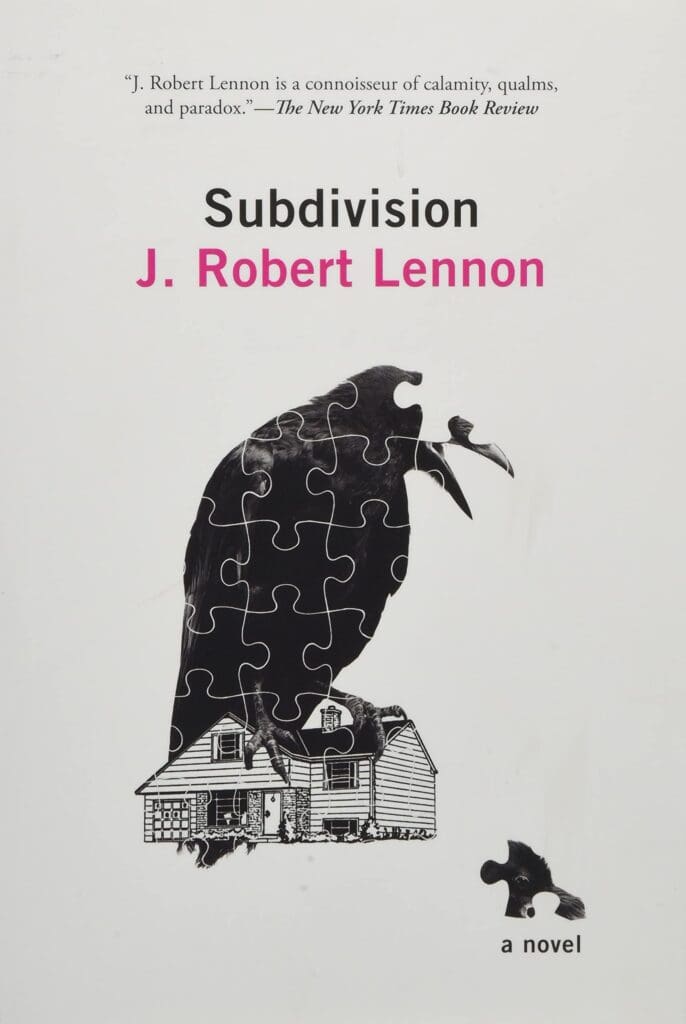On the cover of J. Robert Lennon’s latest novel, Subdivision (256 pages; Graywolf Press), is a puzzle. A large crow sits on top of a quaint-looking house, and the whole image is fragmented into jigsaw pieces. Whoever has been working on this puzzle has almost completed it; just a single piece lays missing from the whole: the eye of the crow.
But as we flip past the cover and set our eyes on the first page of the book, it becomes clear that Subdivision’s puzzle is just beginning—literally, as an unnamed narrator checking herself into a guesthouse is immediately invited by her two hosts to work on a jigsaw puzzle. She describes the dimensions of the puzzle, but it is so incomplete that “what image it might eventually reveal was unclear to me.” The box with the full picture is missing as well, and the pile of pieces are similarly unhelpful: “They were so tiny that the information they conveyed could mean literally anything.”
With this enigmatic opening, we, along with the protagonist, are thrown into an uncanny small town called the Subdivision. The narrator is a newcomer to the Subdivision, but she has no memory of who she is or what has happened to her before arriving here. She has tasks she “needs” to do—look for a new house, run errands, get a job—but there’s no indication as to the motivations behind these tasks. She simply goes through the motions, never asking herself why.
The setting of the novel furthers this uncertainty. In the Subdivision, people, places, and even objects behave in ways they normally wouldn’t, and certain laws of logic and probability that govern our world no longer apply. A house the narrator visits has tiny rooms filled with fractions of furniture; a dangerous creature called the “bakemono” shapeshifts into a handsome and sexually alluring young man; a bus is covered with a paint so black that it simply looks like a “bus-shaped hole in the middle of this sunny day.” The town even seems hostile to the narrator, unwelcome to her efforts to make a new life for herself there.
In the midst of this new environment, the narrator has a single source of help and comfort: a digital assistant named Cylvia. At first, Cylvia acts like a portable Amazon Alexa, providing helpful information to the narrator as she navigates the Subdivision. But later, Cylvia’s capabilities as a digital assistant seem to expand, and she starts to offer assessments of probable future events and give direct commands. “In the morning, go to the Courthouse and ask to see a man named Bruce, who will give you a job,” Cylvia tells her. “Please retrieve the child from the Oracle,” she says.
At one point, Cylvia notes to the narrator that “succumbing to [the bakemono] could significantly delay your progress,” to which the narrator responds: “What progress is that?” Indeed, this is hard to know—even the reader cannot answer that. But Cylvia’s guidance, enigmatic as it is, pushes the narrator into action, and forces her to move toward something, even if she doesn’t know why.
Lennon has an artful ability to place his readers in the exact position as his narrator: a state of complete unknowing. We similarly enter the novel unsure of where we are, where we are going, and why we are even here in the first place. Like the puzzle in the guesthouse, we are missing the bigger picture—the box that shows us the final image.
Only by putting our blind trust in the author—our guide, our Cylvia—are we able to make our way through the labyrinth of Subdivision. As we continue to read, Lennon drops small hints and clues as to the narrator’s backstory, and gradually makes familiar the new world we are in. Characters that at first seemed unfriendly are shown to be endearing in their own ways, and larger themes of trauma, recovery, and motherhood begin to shape the story into a whole. The narrator’s vague and fragmented past slowly comes into clarity.
Finishing a book can feel like placing that last piece into a puzzle. The whole is complete; we finally have all the parts to comprehend the full image. We may be tempted to think this about Subdivision, too—as if we can move that crow’s eye on the cover to its correct place. But Lennon does not disclose every one of his secrets; not everything can be explained away. He leaves just enough unresolved to keep us wondering. Strange and subtle, disconcerting and delightful, Subdivision proves a masterful mystery until its very end.


One thought on “‘Subdivision’ by J. Robert Lennon: The Missing Pieces”